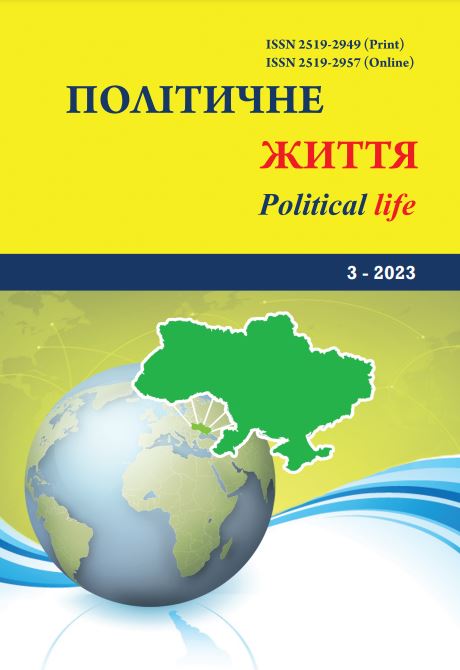Elements of crisis communication in party management processes
DOI:
https://doi.org/10.31558/2519-2949.2023.3.6Keywords:
political party; party crisis; crisis communication; information and communication technologies; party system; organizational crisis; ideological crisisAbstract
The article is devoted to the study of the problems of the application of crisis communication technologies in the field of party management. Crisis communication is actively used in the field of public administration and in the field of business process management. Taking into account the fact that a political party is a kind of "political enterprise", uses marketing technologies in its activities, is constantly in a competitive environment and functions within the boundaries of the political market, certain elements of crisis communication that are used in the field of public administration and business environment may be relevant for the field of party management.
During the decades of its development, party structures experienced crisis phenomena caused by the expansion of electoral rights and the emergence of new social groups, the crisis of classical ideologies and the spread of post-material values, the spread of populism and the emergence of decentralized party structures. At each of these stages, political parties either qualitatively changed their own structure and integrated into the new political reality, or their structure underwent a decline, which consisted in party splits and subsequent absorption by more effective structures.
The purpose of the article was to consider the main crisis trends that may threaten party structures at the current stage, the mechanisms of their prevention and resolution. Solving the specified research tasks necessitated the use of a wide range of methods, such as historical, comparative, institutional, and structural-functional.
As a result of the research, it is possible to develop a generalized model of crisis communication that can be applied in the field of party management. This model consists of the following stages, among which it is possible to distinguish: creation of a plan of anti-crisis measures taking into account all possible scenarios of the development of the crisis; adequately assess the scale and threats posed by crisis phenomena at the initial stage; rationally distribute responsibilities within the team for the implementation of anti-crisis measures; create an informative message that would clearly answer the most pressing questions. It should be short and as specific as possible to significantly narrow the range of its possible interpretations; the message must be disseminated through a relevant communication channel; build an effective feedback system, which should be aimed both at the internal party environment and to obtain a reaction from external stakeholders.
References
Афанасьєв О. Діджиталізаційні тренди сучасних українських партій. URL: https://kse.ua/wp-content/uploads/2020/06/Afanasyev-O.-Didzhitalizatsiyni-trendisuchasnih-ukrayinskih-partiy-converted.pdf (дата звернення 31.08.2023)
Волгов М. Багаторівневі політичні партії та тренд децентралізації: теоретичний аспект у сучасному англомовному науковому дискурсі. Наукові записки Інституту політичних і етнонаціональних досліджень ім. І.Ф. Кураса Національної академії наук України. 2013. № 6 (68). URL: https://ipiend.gov.ua/wp-content/ uploads/2018/07/volgov_bagatorivnevi.pdf (дата звернення 12.09.2023)
Копинець Ю. Інституційна криза політичних партій на початку ХХ століття та характеристика сучасних тенденцій їх розвитку. Вісник Львівського університету. Серія філос.-політолог. студії. 2020. №30. С. 146–153. URL: http://fps-visnyk.lnu.lviv.ua/archive/30_2020/22.pdf (дата звернення 19.08.2023)
Мацієвський Ю. Від партій субститутів до справжніх партій: чи можливо це в Україні? Політичні партії і вибори: збірник статей і тез за результатами четвертої міжнародної наукової конференції кафедри політології «Політичні партії і вибори: українські та світові практики» (пам’яті Юрія Романовича Шведи) від 9 листопада 2019 року. Львів: Львівський національний університет імені Івана Франка, 2020. С. 282–286. URL: https://eprints.oa.edu.ua/8388/ (дата звернення 12.09.2023)
Одарченко К. Впливи кризи політичних партій в Україні на горизонтальні партійні зв`язки через призму ідеологічного та програмного компонента. EUROPEAN POLITICAL AND LAW DISCOURSE. 2017. №4. С. 128–134. URL: https://eppd13.cz/wp-content/uploads/2017/2017-4-1/23.pdf (дата звернення 2.09.2023)
Примуш М. Ідеологічна криза українських політичних партій. Вісник Національного університету «Юридична академія України імені Ярослава Мудрого». 2014. №1. С. 195–202. URL: https://studies.in.ua/pravo/2014_1_23.pdf (дата звернення 14.09.2023)
Шипунов Г. Партії «нової політики» як феномен постіндустріального суспільства:ідейно-інституційні особливості. Панорама політологічних студій. Науковий вісник Рівненського державного гуманітарного університету. 2016. Вип. 14. С. 211–218. URL: https://politologia-rdgu.rv.ua/images/pan14/211.pdf (дата звернення 12.09.2023)
Hopkin J. Political Decentralization, Electoral Change and PartyOrganizational Adaptation A Framework for Analysis. European Urban and Regional Studies. 2003. Т. 10. №. 3.С. 227-237.
Michels R. Political Parties. A Sociological Study of the Oligarchical Tendencies of Modern Democracy. New York, 1968. 194 p.

